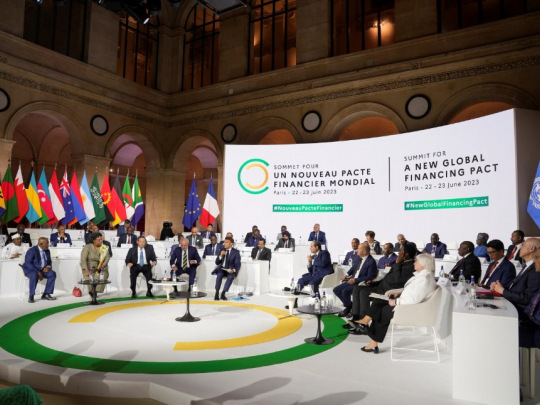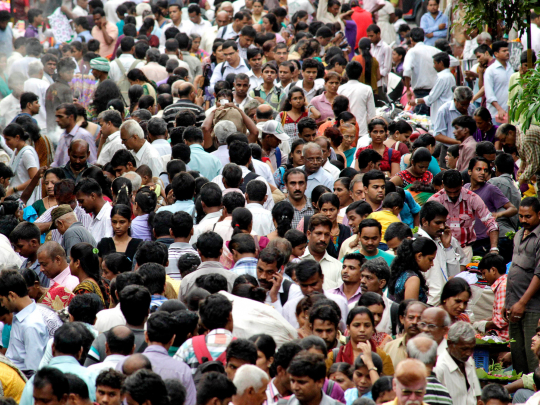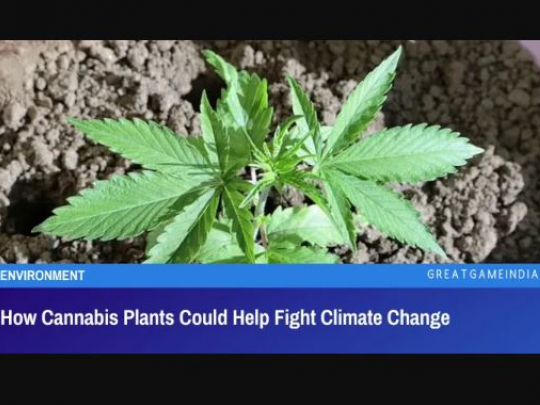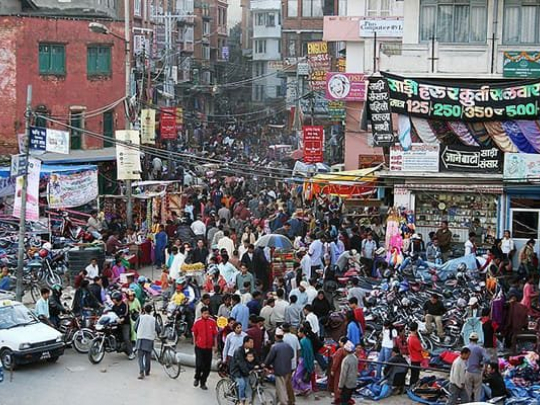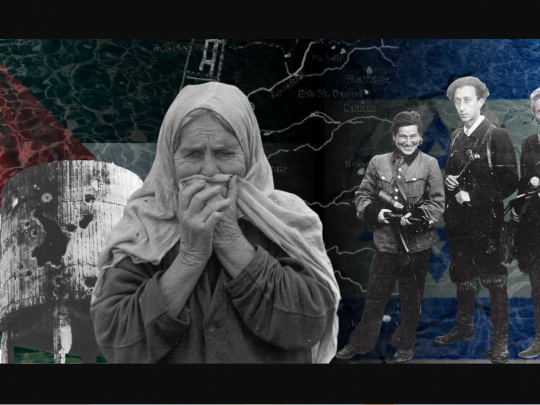How Israel’s Occupation of Palestine Intensifies Climate Change
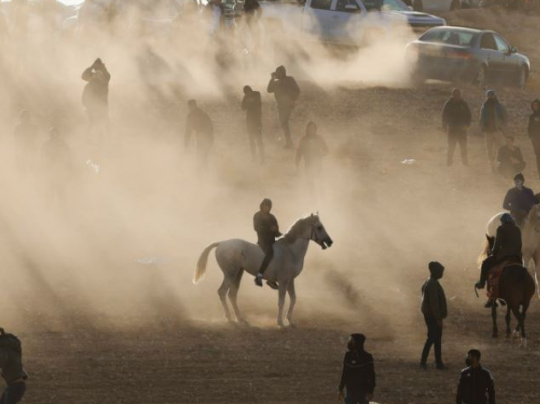
On Sunday, roughly 200 activists demonstrated outside Israeli Prime Minister Naftali Bennett’s office in Jerusalem against the Jewish National Fund’s (JNF) tree-planting project in al-Naqab, maintaining the forestation is an attempt to displace the indigenous Bedouin population.
Contracted by the Israeli government, the JNF razed fruit trees and seeded fields in al-Naqab in January to “make the desert bloom” with non-native plants. The purported environmental project has been met with fierce protest from the local villagers, with more than 60 Bedouin arrested in the last few weeks.
JNF maintains that its actions in al-Naqab encourage sustainability, but other organizations disagree. The Society for the Protection of Nature in Israel took the JNF to the Supreme Court last year after its research found that JNF’s afforestation will harm the area’s biodiversity. The High Court sided with the JNF.
Greenwashing is a cornerstone of the Zionist movement, in which Israel tries to paint Palestine as a desolate wasteland in need of a Jewish green thumb. While these environmental projects might appear well-intentioned in an area warming faster than the global average, experts and activists agree that Israel’s occupation is making climate change worse.
The environmental issue in Palestine
Palestine is particularly vulnerable to climate change. ClimaSouth, a European Union-funded project supporting climate-change mitigation in Mediterranean countries, predicts annual rainfall will drop by 30% in the eastern Mediterranean region by the end of the 21st century. The Intergovernmental Panel on Climate Change predicts that the southern and eastern Mediterranean areas will warm at a higher rate than the rest of the world over the next century. According to the United Nations Environment Program, Palestine may see an increase in temperature of more than 7 degrees Fahrenheit by 2100. Sea levels are also expected to rise by 1.2 to 3.3 feet by 2100.
Zena Agha, Palestinian-Iraqi writer and non-resident scholar at the Middle East Institute, explained that these climate change effects translate to significant political consequences for Palestinians:
Although Palestinians and Israelis inhabit the same territory — whether they’re settlers living in the occupied West Bank, Palestinian citizens of Israel living on the seafront, or Palestinians living in Gaza — Palestinians will always suffer the effects of climate change more starkly as a direct response to Israeli policy.”
Israel wrecking Palestinians’ climate resilience
Palestine’s location makes it particularly susceptible to global warming, but for a people under military occupation the threat of climate catastrophe is multiplied and their ability to adapt to it is severely impacted.
Climate-related hazards have already manifested as a result of Israeli policy. Research from Visualizing Palestine, an organization developing data-driven tools to better understand Palestine, found that Palestinians are experiencing food insecurity, land and soil degradation, and water scarcity owing to the occupation. According to figures cited in their “Environmental Justice in Palestine” visual series, 85% of the West Bank’s water resources are controlled by Israel, and 69% of Gaza and 33% of West Bank households are food insecure.
In mid-January, Gaza’s streets were ravaged by flooding after several days of heavy rainfall. The municipality of Gaza City blamed Israel’s assault on the Strip in May for damaging its infrastructure, making it more prone to flooding.
During a webinar hosted by Visualizing Palestine, Asmaa Abu Mezied, an economic-development and social-inclusion specialist working with Oxfam, explained how Israel’s 14-year blockade on Gaza — in which the state controls what goes in and out of Gaza — has also dramatically affected the besieged Strip’s resilience to climate change. “What the Palestinians are witnessing in Gaza is their adaptive capacity has already been exhausted financially, socially, and economically over the past decade because of the blockade, and that would leave them much more vulnerable to floods,” Abu Mezied said.
Natasha Westheimer, a water-management specialist, explained to MintPress News how Israeli policy restricts Palestine’s ability to develop sustainable and reliable water resources:
The occupation makes it really difficult for Palestinians to build resilience to the climate crisis because it essentially removes capacity for self-determination and for building out resources that can support in building preparedness to adapt to the impacts of climate change. And you see that pretty acutely with the water sector.”
Westheimer explained that this injustice is demonstrated on both the local scale and on the national level. In the southern West Bank, communities don’t have access to a continuous supply of water and so rely on expensive water trucks or rainwater collection. Yet their water infrastructure is often targeted and destroyed by the Israeli military and settlers.
Nationally, 97% of Gaza’s coastal aquifer — the area’s main water supply — is unfit for drinking. The Strip’s efforts to expand its water access through a desalination plant are hampered, moreover, by the Israeli blockade. Westheimer explained that most materials needed for a desalination plant are considered dual-use materials by Israel, meaning they can be used for civilian and military purposes, and so the state puts restrictions on these materials’ import into Gaza. “The project faces a number of what Israel calls bureaucratic obstacles, but is mainly a system of blockade, seizure, and control, and it’s eliminating Gaza’s ability to meet the basic needs of its population,” Westheimer said.
In addition to harming its adaptive capabilities, Israel’s near 74-year occupation has also drastically deteriorated Palestine’s environment. Professor Mazin Qumsiyeh, founder and director of the Palestine Institute for Biodiversity and Sustainability of Bethlehem University, detailed the myriad of ways Israeli control has damaged ecosystems.
He cited the razing of native trees to plant European pine trees; diversion of the Jordan Valley’s water; draining of wetlands; how the building of the apartheid wall uprooted more than 2 million trees; and how industrial settlements have turned the West Bank into a toxic waste dumpsite. “All of this has damaged the Palestinian environment and transformed the landscape and transformed the communities,” Qumsiyeh told MintPress News.
As explained in Visualizing Palestine’s webinar and illustrated in its Environmental Justice in Palestine infographics, Israel’s environmental racism and green colonialism has made the land almost uninhabitable for Palestinians.
Israel uses parks and nature reserves to hide the ruins of Palestinian villages depopulated during the Nakba, Israel’s ethnic cleansing campaign of Palestine in 1947-48. These green spaces also act as a way to further displace Palestinians and restrict their development.
Fifteen Israeli facilities process waste in the West Bank, in violation of international law. Settlement industrial zones in the West Bank also adhere to less rigorous environmental standards. Israeli control of building permits in Area C of the West Bank has stunted the area’s ability to develop proper waste infrastructure. How Israel treats waste here has then turned the West Bank into a land plagued by garbage.
Israel is a militarized and industrialized society. These two factors, Qumsiyeh explained, have increased its greenhouse gas emissions. “Like the United States, [Israel] has a very big military compared to its GDP. And the military is one of the largest producers of greenhouse gas emissions,” Qumsiyeh said. “The Palestinian areas being dedeveloped and deindustrialized contribute very little to the global greenhouse gases, but we are more impacted by climate change.”
Greenwashing apartheid
According to the most recently available data, Israel released more than 56 million tons of fossil CO2 gasses in 2020. By comparison, Palestine released 2.9 million tons of CO2 gasses in 2020. Israel’s ecological footprint stood at 5.5 global hectares per person in 2017, as reported by the Global Footprint Network, while Palestine’s was 1.8.
Jessica Anderson, deputy director at Visualizing Palestine, stressed how this environmental measurement illustrates the extreme inequality produced by occupation and oppression.
“Israel is not unique in its contributions to climate change,” Anderson said. “It’s part of this global cadre of governments and corporations that exacerbate the climate crisis through their heavy military investments, resource hoarding, overconsumption, and extractive economies.”
Last year’s United Nations Climate Change Conference (or COP26) exemplifies how the international community is approaching the climate issue, Anderson said, in a way that ignores indigenous populations. While Israel was able to send 120 delegates to the conference, Palestinians from the occupied territories couldn’t participate because their vaccines weren’t recognized.
“Platforms like this are marginalizing people that are on the frontlines of the climate crisis while providing a platform for governments and corporations to greenwash their image,” Anderson said. “So, there’s a failure to grapple with the systemic and political dimensions of the climate crisis that leaves Palestinians out and allows Israel to be highlighted.”
During Visualizing Palestine’s webinar, Agha stated the relationship between the international community and the Palestinian Authority (PA) warrants scrutiny. She emphasized what she labeled the paradox of the PA, whereby the international community is applying the same metrics to Palestine and Israel in assessing their environmental progress.“ The PA has little sovereign jurisdiction over its natural resources nor over large swathes of its territory,” Agha told MintPress News. “It wields no independent political will over how to manage climate change, yet it’s still tasked with addressing climate change.”
Palestine’s fragmented political landscape, in which Gaza is ruled by the political party Hamas and the West Bank by the political party Fatah, also weakens its ability to manage a crisis of this magnitude.
For Agha, the international and donor communities’ treatment of the climate crisis in Palestine as a socioeconomic catastrophe and not a political catastrophe is part of the problem and creates unproductive solutions. But from her perspective, it’s important to remember the real culprit here: occupation. “Israel’s actions over the last almost 75 years demonstrate that there is very little regard for the indigenous landscape, the indigenous flora and fauna, the wildlife population, and the indigenous people,” she said.
- Source : Jessica Buxbaum - MintPress News





